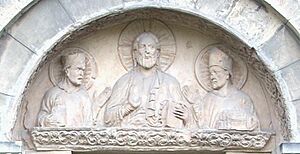Epiphanius of Pavia facts for kids
Quick facts for kids Epiphanius of Pavia |
|
|---|---|

Tympanon depicting Christ, Saint Godehard and Epiphanius, on the St. Godehard Basilica in Hildesheim, Germany.
|
|
| Born | 438 Pavia |
| Died | January 21, 496 (aged 57–58) |
| Venerated in | Orthodox Church Roman Catholic Church |
| Feast | 21 January |
Epiphanius of Pavia (438–496) was an important church leader. He later became known as Saint Epiphanius of Pavia. He served as the Bishop of Pavia from 466 until his death in 496. Before becoming a bishop, he held other church roles. These included lector (someone who reads scripture), subdeacon, and deacon.
During his life, Epiphanius went on many important church missions. Two of his most famous journeys were as an emissary (a special messenger) for Emperor Julius Nepos. He traveled to meet the Visigothic king Euric to discuss peace. He also went to Ravenna to speak with Theodoric the Great. This was after Theodoric defeated Odoacer. Epiphanius asked Theodoric to give back the civic rights (basic rights as a citizen) to Roman nobles. These nobles had supported Odoacer.
Contents
Epiphanius's Life and Work
Most of what we know about Epiphanius comes from a book called Vita Epifanius. This book was written by Magnus Felix Ennodius. Ennodius knew Epiphanius well and even traveled with him.
Early Life and Becoming a Bishop
Epiphanius was born in 438. His father was Maurus and his mother was Focaria. She was related to Mirocles, an earlier bishop of Milan. When Epiphanius was eight years old, he joined the household of Bishop Crispinus. There, he learned to read, write, and even stenography (a fast way of writing).
At 18, he became a subdeacon. At 20, he became a deacon. When Bishop Crispinus was dying, he chose Epiphanius to be his successor. Epiphanius was made bishop in Milan when he was 28. He was reluctant at first but accepted the role.
Working for Peace
Soon after becoming bishop, Epiphanius was asked to help. He tried to make peace between Anthemius, the Roman emperor, and Ricimer, a powerful barbarian leader. Epiphanius appealed to both sides for peace. However, his efforts did not succeed. Violence broke out, and Anthemius was eventually killed.
Even though this mission failed, many of Epiphanius's other efforts were successful. Church leaders like him had a lot of influence. They could speak with rulers and nobles during this time.
Diplomatic Missions
In 475, Emperor Julius Nepos sent Epiphanius on a special mission. He was to talk to King Euric about attacks by the Visigoths. Epiphanius helped to make a peace agreement. However, Emperor Nepos was removed from power soon after.
Epiphanius also successfully asked Odoacer to stop a greedy official named Pelagius. This helped many people who were suffering.
Helping His Sister and Others
Epiphanius also helped his sister, Honorata. She had been taken from a monastery in Pavia during a war. This war was between Theodoric the Great and Odoacer. Epiphanius successfully negotiated for her ransom (payment to free a captive).
After Theodoric won the war, he punished Romans who had supported Odoacer. He took away their civic rights. Epiphanius went to Theodoric and asked him to restore these rights. Theodoric agreed. But he asked Epiphanius to do something in return. Epiphanius had to negotiate with the Burgundians. He needed to ransom captives they had taken from Liguria during the war.
Epiphanius's Death
Epiphanius died on January 21, 496. He was 58 years old. His death followed a difficult winter journey to Burgundy for his diplomatic work. He had served the church for 30 years.
Veneration
After Epiphanius died, Ennodius wrote his "Life" (a Vita). This book helped people remember Epiphanius's good deeds. Epiphanius's relics (his remains) were moved to Hildesheim in 963. They are kept there in a special container called a reliquary.
Even though his main relics were moved, people in Pavia still believed they had some of his remains. In the 18th century, they reburied what they thought was his body. Later, these relics were moved to another church. In 1834, the Bishop of Pavia officially recognized these remains as authentic.

